NURS2003: Asthma Case Study - Pathophysiology and Pharmacology
VerifiedAdded on 2023/01/19
|8
|2806
|48
Case Study
AI Summary
This case study examines the case of Benji Smith, an 11-year-old boy presenting with a moderate exacerbation of asthma. The assignment delves into the pathophysiology of Benji's condition, focusing on the symptoms of coughing, wheezing, and breathlessness, linking them to the underlying mechanisms of asthma. It analyzes the pharmacological interventions employed, including salbutamol, ipratropium, and oral prednisolone, explaining their mechanisms of action and their roles in managing the patient's symptoms. The study highlights the importance of these medications in alleviating symptoms like wheezing, reducing airway inflammation, and improving breathing. The case study offers a detailed analysis of how these medications were used to treat Benji's asthma. The assignment references relevant literature to support the discussion of asthma's pathophysiology and pharmacology. The paper also offers a detailed understanding of the assessment criteria, including the ability to explain the pathophysiology of the primary illness, identify and discuss relevant signs and symptoms, and explain pharmacological interventions, including the ADME principles of each medication.

UNIT:
NAME:
DATE:
NAME:
DATE:
Paraphrase This Document
Need a fresh take? Get an instant paraphrase of this document with our AI Paraphraser
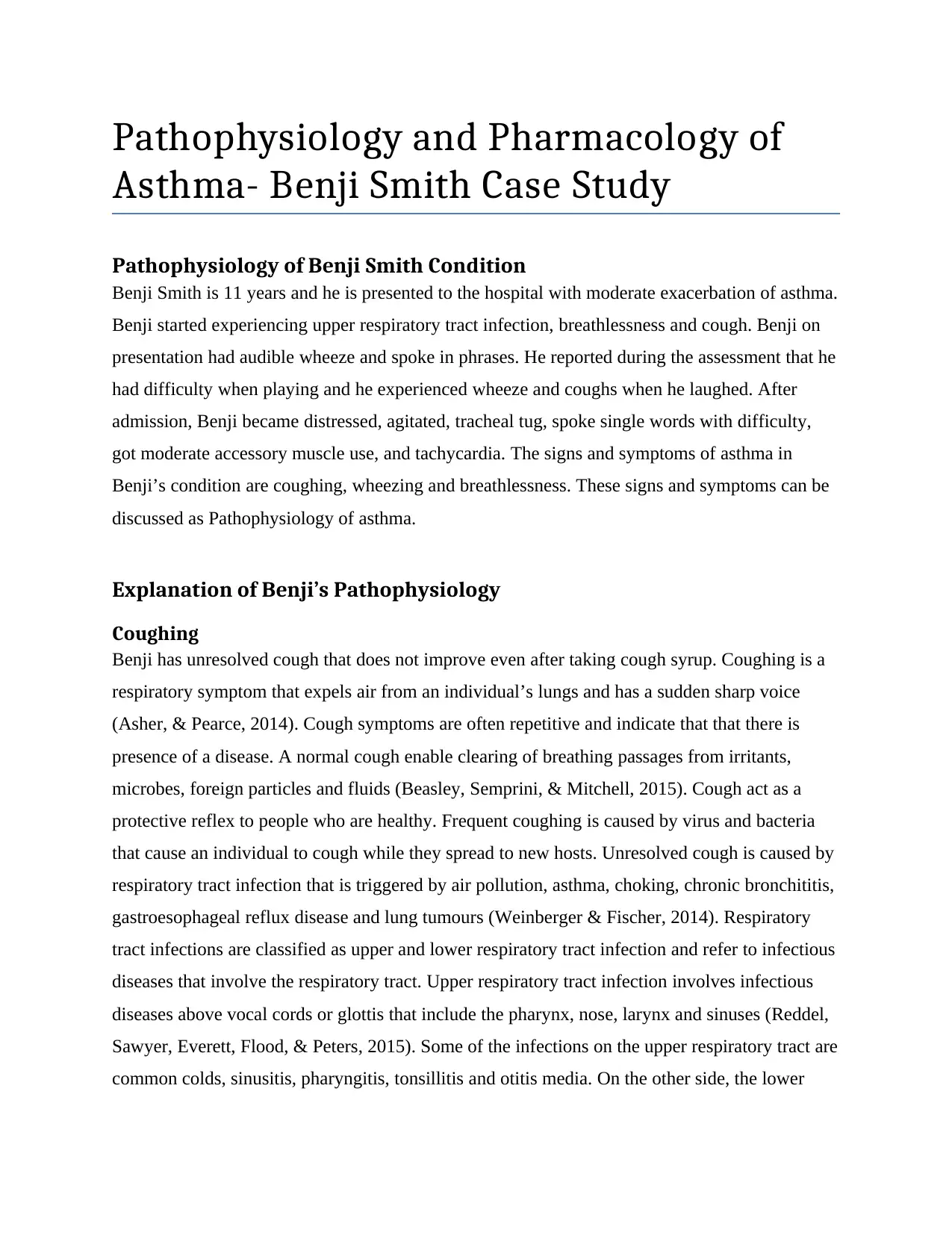
Pathophysiology and Pharmacology of
Asthma- Benji Smith Case Study
Pathophysiology of Benji Smith Condition
Benji Smith is 11 years and he is presented to the hospital with moderate exacerbation of asthma.
Benji started experiencing upper respiratory tract infection, breathlessness and cough. Benji on
presentation had audible wheeze and spoke in phrases. He reported during the assessment that he
had difficulty when playing and he experienced wheeze and coughs when he laughed. After
admission, Benji became distressed, agitated, tracheal tug, spoke single words with difficulty,
got moderate accessory muscle use, and tachycardia. The signs and symptoms of asthma in
Benji’s condition are coughing, wheezing and breathlessness. These signs and symptoms can be
discussed as Pathophysiology of asthma.
Explanation of Benji’s Pathophysiology
Coughing
Benji has unresolved cough that does not improve even after taking cough syrup. Coughing is a
respiratory symptom that expels air from an individual’s lungs and has a sudden sharp voice
(Asher, & Pearce, 2014). Cough symptoms are often repetitive and indicate that that there is
presence of a disease. A normal cough enable clearing of breathing passages from irritants,
microbes, foreign particles and fluids (Beasley, Semprini, & Mitchell, 2015). Cough act as a
protective reflex to people who are healthy. Frequent coughing is caused by virus and bacteria
that cause an individual to cough while they spread to new hosts. Unresolved cough is caused by
respiratory tract infection that is triggered by air pollution, asthma, choking, chronic bronchititis,
gastroesophageal reflux disease and lung tumours (Weinberger & Fischer, 2014). Respiratory
tract infections are classified as upper and lower respiratory tract infection and refer to infectious
diseases that involve the respiratory tract. Upper respiratory tract infection involves infectious
diseases above vocal cords or glottis that include the pharynx, nose, larynx and sinuses (Reddel,
Sawyer, Everett, Flood, & Peters, 2015). Some of the infections on the upper respiratory tract are
common colds, sinusitis, pharyngitis, tonsillitis and otitis media. On the other side, the lower
Asthma- Benji Smith Case Study
Pathophysiology of Benji Smith Condition
Benji Smith is 11 years and he is presented to the hospital with moderate exacerbation of asthma.
Benji started experiencing upper respiratory tract infection, breathlessness and cough. Benji on
presentation had audible wheeze and spoke in phrases. He reported during the assessment that he
had difficulty when playing and he experienced wheeze and coughs when he laughed. After
admission, Benji became distressed, agitated, tracheal tug, spoke single words with difficulty,
got moderate accessory muscle use, and tachycardia. The signs and symptoms of asthma in
Benji’s condition are coughing, wheezing and breathlessness. These signs and symptoms can be
discussed as Pathophysiology of asthma.
Explanation of Benji’s Pathophysiology
Coughing
Benji has unresolved cough that does not improve even after taking cough syrup. Coughing is a
respiratory symptom that expels air from an individual’s lungs and has a sudden sharp voice
(Asher, & Pearce, 2014). Cough symptoms are often repetitive and indicate that that there is
presence of a disease. A normal cough enable clearing of breathing passages from irritants,
microbes, foreign particles and fluids (Beasley, Semprini, & Mitchell, 2015). Cough act as a
protective reflex to people who are healthy. Frequent coughing is caused by virus and bacteria
that cause an individual to cough while they spread to new hosts. Unresolved cough is caused by
respiratory tract infection that is triggered by air pollution, asthma, choking, chronic bronchititis,
gastroesophageal reflux disease and lung tumours (Weinberger & Fischer, 2014). Respiratory
tract infections are classified as upper and lower respiratory tract infection and refer to infectious
diseases that involve the respiratory tract. Upper respiratory tract infection involves infectious
diseases above vocal cords or glottis that include the pharynx, nose, larynx and sinuses (Reddel,
Sawyer, Everett, Flood, & Peters, 2015). Some of the infections on the upper respiratory tract are
common colds, sinusitis, pharyngitis, tonsillitis and otitis media. On the other side, the lower
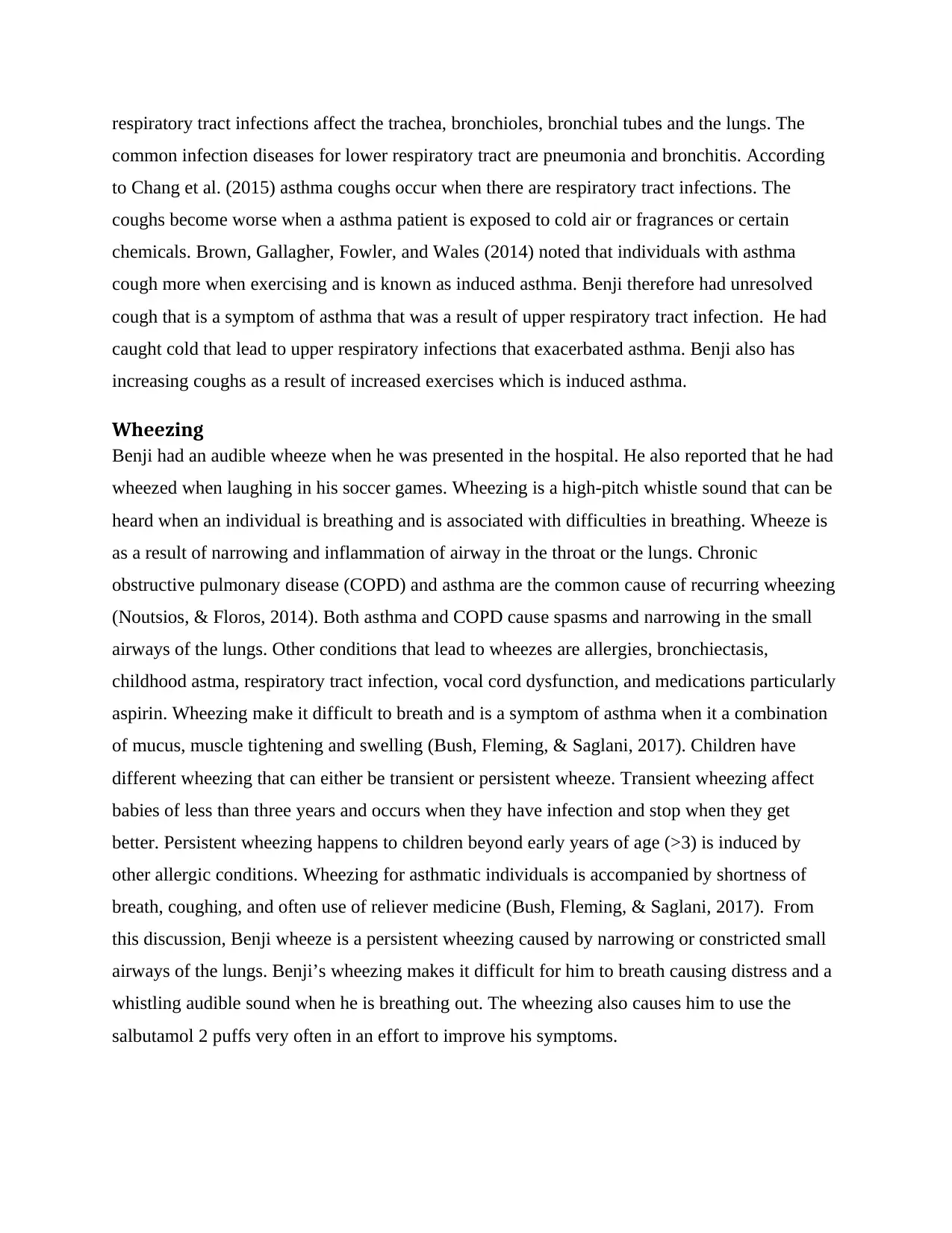
respiratory tract infections affect the trachea, bronchioles, bronchial tubes and the lungs. The
common infection diseases for lower respiratory tract are pneumonia and bronchitis. According
to Chang et al. (2015) asthma coughs occur when there are respiratory tract infections. The
coughs become worse when a asthma patient is exposed to cold air or fragrances or certain
chemicals. Brown, Gallagher, Fowler, and Wales (2014) noted that individuals with asthma
cough more when exercising and is known as induced asthma. Benji therefore had unresolved
cough that is a symptom of asthma that was a result of upper respiratory tract infection. He had
caught cold that lead to upper respiratory infections that exacerbated asthma. Benji also has
increasing coughs as a result of increased exercises which is induced asthma.
Wheezing
Benji had an audible wheeze when he was presented in the hospital. He also reported that he had
wheezed when laughing in his soccer games. Wheezing is a high-pitch whistle sound that can be
heard when an individual is breathing and is associated with difficulties in breathing. Wheeze is
as a result of narrowing and inflammation of airway in the throat or the lungs. Chronic
obstructive pulmonary disease (COPD) and asthma are the common cause of recurring wheezing
(Noutsios, & Floros, 2014). Both asthma and COPD cause spasms and narrowing in the small
airways of the lungs. Other conditions that lead to wheezes are allergies, bronchiectasis,
childhood astma, respiratory tract infection, vocal cord dysfunction, and medications particularly
aspirin. Wheezing make it difficult to breath and is a symptom of asthma when it a combination
of mucus, muscle tightening and swelling (Bush, Fleming, & Saglani, 2017). Children have
different wheezing that can either be transient or persistent wheeze. Transient wheezing affect
babies of less than three years and occurs when they have infection and stop when they get
better. Persistent wheezing happens to children beyond early years of age (>3) is induced by
other allergic conditions. Wheezing for asthmatic individuals is accompanied by shortness of
breath, coughing, and often use of reliever medicine (Bush, Fleming, & Saglani, 2017). From
this discussion, Benji wheeze is a persistent wheezing caused by narrowing or constricted small
airways of the lungs. Benji’s wheezing makes it difficult for him to breath causing distress and a
whistling audible sound when he is breathing out. The wheezing also causes him to use the
salbutamol 2 puffs very often in an effort to improve his symptoms.
common infection diseases for lower respiratory tract are pneumonia and bronchitis. According
to Chang et al. (2015) asthma coughs occur when there are respiratory tract infections. The
coughs become worse when a asthma patient is exposed to cold air or fragrances or certain
chemicals. Brown, Gallagher, Fowler, and Wales (2014) noted that individuals with asthma
cough more when exercising and is known as induced asthma. Benji therefore had unresolved
cough that is a symptom of asthma that was a result of upper respiratory tract infection. He had
caught cold that lead to upper respiratory infections that exacerbated asthma. Benji also has
increasing coughs as a result of increased exercises which is induced asthma.
Wheezing
Benji had an audible wheeze when he was presented in the hospital. He also reported that he had
wheezed when laughing in his soccer games. Wheezing is a high-pitch whistle sound that can be
heard when an individual is breathing and is associated with difficulties in breathing. Wheeze is
as a result of narrowing and inflammation of airway in the throat or the lungs. Chronic
obstructive pulmonary disease (COPD) and asthma are the common cause of recurring wheezing
(Noutsios, & Floros, 2014). Both asthma and COPD cause spasms and narrowing in the small
airways of the lungs. Other conditions that lead to wheezes are allergies, bronchiectasis,
childhood astma, respiratory tract infection, vocal cord dysfunction, and medications particularly
aspirin. Wheezing make it difficult to breath and is a symptom of asthma when it a combination
of mucus, muscle tightening and swelling (Bush, Fleming, & Saglani, 2017). Children have
different wheezing that can either be transient or persistent wheeze. Transient wheezing affect
babies of less than three years and occurs when they have infection and stop when they get
better. Persistent wheezing happens to children beyond early years of age (>3) is induced by
other allergic conditions. Wheezing for asthmatic individuals is accompanied by shortness of
breath, coughing, and often use of reliever medicine (Bush, Fleming, & Saglani, 2017). From
this discussion, Benji wheeze is a persistent wheezing caused by narrowing or constricted small
airways of the lungs. Benji’s wheezing makes it difficult for him to breath causing distress and a
whistling audible sound when he is breathing out. The wheezing also causes him to use the
salbutamol 2 puffs very often in an effort to improve his symptoms.
⊘ This is a preview!⊘
Do you want full access?
Subscribe today to unlock all pages.

Trusted by 1+ million students worldwide
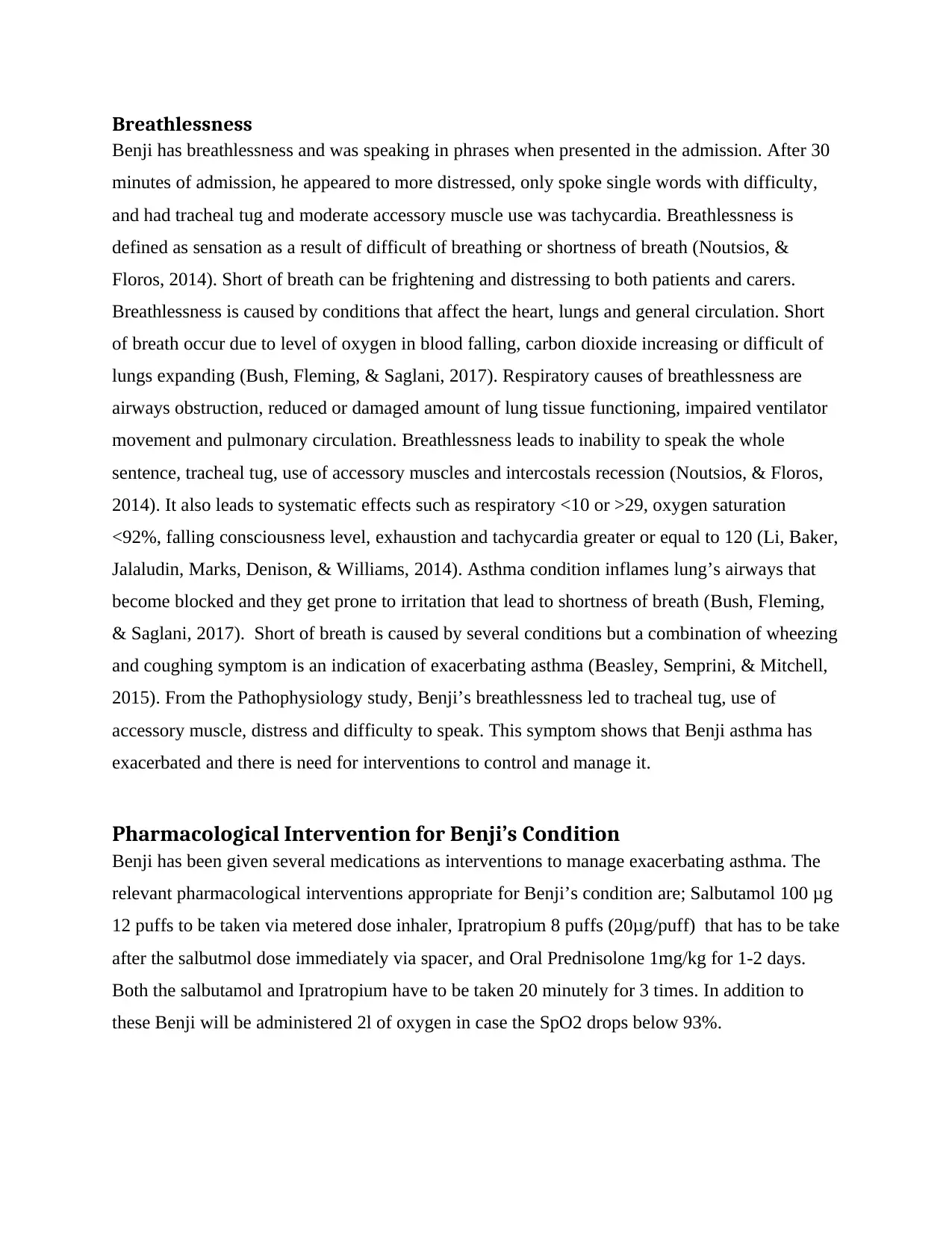
Breathlessness
Benji has breathlessness and was speaking in phrases when presented in the admission. After 30
minutes of admission, he appeared to more distressed, only spoke single words with difficulty,
and had tracheal tug and moderate accessory muscle use was tachycardia. Breathlessness is
defined as sensation as a result of difficult of breathing or shortness of breath (Noutsios, &
Floros, 2014). Short of breath can be frightening and distressing to both patients and carers.
Breathlessness is caused by conditions that affect the heart, lungs and general circulation. Short
of breath occur due to level of oxygen in blood falling, carbon dioxide increasing or difficult of
lungs expanding (Bush, Fleming, & Saglani, 2017). Respiratory causes of breathlessness are
airways obstruction, reduced or damaged amount of lung tissue functioning, impaired ventilator
movement and pulmonary circulation. Breathlessness leads to inability to speak the whole
sentence, tracheal tug, use of accessory muscles and intercostals recession (Noutsios, & Floros,
2014). It also leads to systematic effects such as respiratory <10 or >29, oxygen saturation
<92%, falling consciousness level, exhaustion and tachycardia greater or equal to 120 (Li, Baker,
Jalaludin, Marks, Denison, & Williams, 2014). Asthma condition inflames lung’s airways that
become blocked and they get prone to irritation that lead to shortness of breath (Bush, Fleming,
& Saglani, 2017). Short of breath is caused by several conditions but a combination of wheezing
and coughing symptom is an indication of exacerbating asthma (Beasley, Semprini, & Mitchell,
2015). From the Pathophysiology study, Benji’s breathlessness led to tracheal tug, use of
accessory muscle, distress and difficulty to speak. This symptom shows that Benji asthma has
exacerbated and there is need for interventions to control and manage it.
Pharmacological Intervention for Benji’s Condition
Benji has been given several medications as interventions to manage exacerbating asthma. The
relevant pharmacological interventions appropriate for Benji’s condition are; Salbutamol 100 μg
12 puffs to be taken via metered dose inhaler, Ipratropium 8 puffs (20μg/puff) that has to be take
after the salbutmol dose immediately via spacer, and Oral Prednisolone 1mg/kg for 1-2 days.
Both the salbutamol and Ipratropium have to be taken 20 minutely for 3 times. In addition to
these Benji will be administered 2l of oxygen in case the SpO2 drops below 93%.
Benji has breathlessness and was speaking in phrases when presented in the admission. After 30
minutes of admission, he appeared to more distressed, only spoke single words with difficulty,
and had tracheal tug and moderate accessory muscle use was tachycardia. Breathlessness is
defined as sensation as a result of difficult of breathing or shortness of breath (Noutsios, &
Floros, 2014). Short of breath can be frightening and distressing to both patients and carers.
Breathlessness is caused by conditions that affect the heart, lungs and general circulation. Short
of breath occur due to level of oxygen in blood falling, carbon dioxide increasing or difficult of
lungs expanding (Bush, Fleming, & Saglani, 2017). Respiratory causes of breathlessness are
airways obstruction, reduced or damaged amount of lung tissue functioning, impaired ventilator
movement and pulmonary circulation. Breathlessness leads to inability to speak the whole
sentence, tracheal tug, use of accessory muscles and intercostals recession (Noutsios, & Floros,
2014). It also leads to systematic effects such as respiratory <10 or >29, oxygen saturation
<92%, falling consciousness level, exhaustion and tachycardia greater or equal to 120 (Li, Baker,
Jalaludin, Marks, Denison, & Williams, 2014). Asthma condition inflames lung’s airways that
become blocked and they get prone to irritation that lead to shortness of breath (Bush, Fleming,
& Saglani, 2017). Short of breath is caused by several conditions but a combination of wheezing
and coughing symptom is an indication of exacerbating asthma (Beasley, Semprini, & Mitchell,
2015). From the Pathophysiology study, Benji’s breathlessness led to tracheal tug, use of
accessory muscle, distress and difficulty to speak. This symptom shows that Benji asthma has
exacerbated and there is need for interventions to control and manage it.
Pharmacological Intervention for Benji’s Condition
Benji has been given several medications as interventions to manage exacerbating asthma. The
relevant pharmacological interventions appropriate for Benji’s condition are; Salbutamol 100 μg
12 puffs to be taken via metered dose inhaler, Ipratropium 8 puffs (20μg/puff) that has to be take
after the salbutmol dose immediately via spacer, and Oral Prednisolone 1mg/kg for 1-2 days.
Both the salbutamol and Ipratropium have to be taken 20 minutely for 3 times. In addition to
these Benji will be administered 2l of oxygen in case the SpO2 drops below 93%.
Paraphrase This Document
Need a fresh take? Get an instant paraphrase of this document with our AI Paraphraser
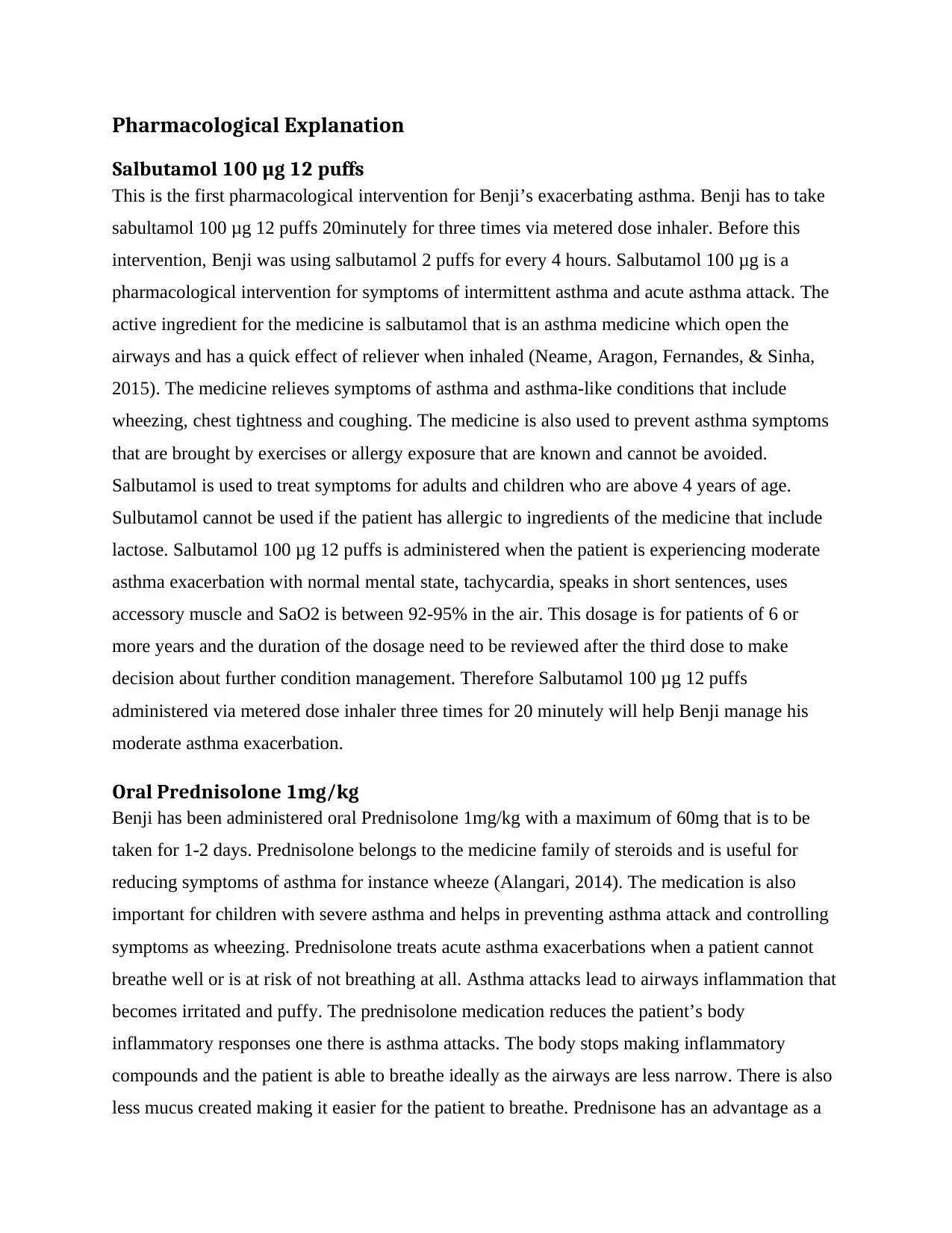
Pharmacological Explanation
Salbutamol 100 μg 12 puffs
This is the first pharmacological intervention for Benji’s exacerbating asthma. Benji has to take
sabultamol 100 μg 12 puffs 20minutely for three times via metered dose inhaler. Before this
intervention, Benji was using salbutamol 2 puffs for every 4 hours. Salbutamol 100 μg is a
pharmacological intervention for symptoms of intermittent asthma and acute asthma attack. The
active ingredient for the medicine is salbutamol that is an asthma medicine which open the
airways and has a quick effect of reliever when inhaled (Neame, Aragon, Fernandes, & Sinha,
2015). The medicine relieves symptoms of asthma and asthma-like conditions that include
wheezing, chest tightness and coughing. The medicine is also used to prevent asthma symptoms
that are brought by exercises or allergy exposure that are known and cannot be avoided.
Salbutamol is used to treat symptoms for adults and children who are above 4 years of age.
Sulbutamol cannot be used if the patient has allergic to ingredients of the medicine that include
lactose. Salbutamol 100 μg 12 puffs is administered when the patient is experiencing moderate
asthma exacerbation with normal mental state, tachycardia, speaks in short sentences, uses
accessory muscle and SaO2 is between 92-95% in the air. This dosage is for patients of 6 or
more years and the duration of the dosage need to be reviewed after the third dose to make
decision about further condition management. Therefore Salbutamol 100 μg 12 puffs
administered via metered dose inhaler three times for 20 minutely will help Benji manage his
moderate asthma exacerbation.
Oral Prednisolone 1mg/kg
Benji has been administered oral Prednisolone 1mg/kg with a maximum of 60mg that is to be
taken for 1-2 days. Prednisolone belongs to the medicine family of steroids and is useful for
reducing symptoms of asthma for instance wheeze (Alangari, 2014). The medication is also
important for children with severe asthma and helps in preventing asthma attack and controlling
symptoms as wheezing. Prednisolone treats acute asthma exacerbations when a patient cannot
breathe well or is at risk of not breathing at all. Asthma attacks lead to airways inflammation that
becomes irritated and puffy. The prednisolone medication reduces the patient’s body
inflammatory responses one there is asthma attacks. The body stops making inflammatory
compounds and the patient is able to breathe ideally as the airways are less narrow. There is also
less mucus created making it easier for the patient to breathe. Prednisone has an advantage as a
Salbutamol 100 μg 12 puffs
This is the first pharmacological intervention for Benji’s exacerbating asthma. Benji has to take
sabultamol 100 μg 12 puffs 20minutely for three times via metered dose inhaler. Before this
intervention, Benji was using salbutamol 2 puffs for every 4 hours. Salbutamol 100 μg is a
pharmacological intervention for symptoms of intermittent asthma and acute asthma attack. The
active ingredient for the medicine is salbutamol that is an asthma medicine which open the
airways and has a quick effect of reliever when inhaled (Neame, Aragon, Fernandes, & Sinha,
2015). The medicine relieves symptoms of asthma and asthma-like conditions that include
wheezing, chest tightness and coughing. The medicine is also used to prevent asthma symptoms
that are brought by exercises or allergy exposure that are known and cannot be avoided.
Salbutamol is used to treat symptoms for adults and children who are above 4 years of age.
Sulbutamol cannot be used if the patient has allergic to ingredients of the medicine that include
lactose. Salbutamol 100 μg 12 puffs is administered when the patient is experiencing moderate
asthma exacerbation with normal mental state, tachycardia, speaks in short sentences, uses
accessory muscle and SaO2 is between 92-95% in the air. This dosage is for patients of 6 or
more years and the duration of the dosage need to be reviewed after the third dose to make
decision about further condition management. Therefore Salbutamol 100 μg 12 puffs
administered via metered dose inhaler three times for 20 minutely will help Benji manage his
moderate asthma exacerbation.
Oral Prednisolone 1mg/kg
Benji has been administered oral Prednisolone 1mg/kg with a maximum of 60mg that is to be
taken for 1-2 days. Prednisolone belongs to the medicine family of steroids and is useful for
reducing symptoms of asthma for instance wheeze (Alangari, 2014). The medication is also
important for children with severe asthma and helps in preventing asthma attack and controlling
symptoms as wheezing. Prednisolone treats acute asthma exacerbations when a patient cannot
breathe well or is at risk of not breathing at all. Asthma attacks lead to airways inflammation that
becomes irritated and puffy. The prednisolone medication reduces the patient’s body
inflammatory responses one there is asthma attacks. The body stops making inflammatory
compounds and the patient is able to breathe ideally as the airways are less narrow. There is also
less mucus created making it easier for the patient to breathe. Prednisone has an advantage as a
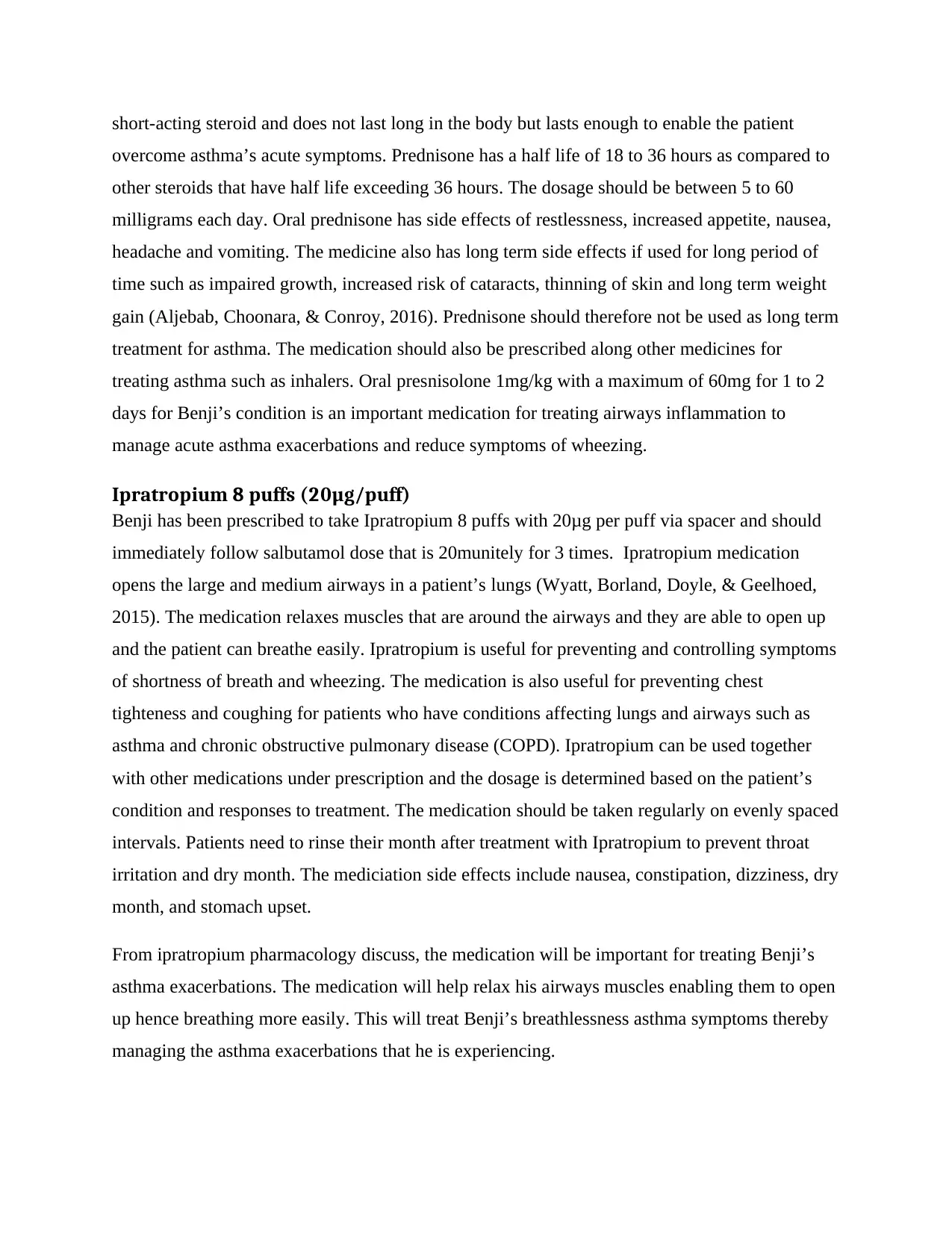
short-acting steroid and does not last long in the body but lasts enough to enable the patient
overcome asthma’s acute symptoms. Prednisone has a half life of 18 to 36 hours as compared to
other steroids that have half life exceeding 36 hours. The dosage should be between 5 to 60
milligrams each day. Oral prednisone has side effects of restlessness, increased appetite, nausea,
headache and vomiting. The medicine also has long term side effects if used for long period of
time such as impaired growth, increased risk of cataracts, thinning of skin and long term weight
gain (Aljebab, Choonara, & Conroy, 2016). Prednisone should therefore not be used as long term
treatment for asthma. The medication should also be prescribed along other medicines for
treating asthma such as inhalers. Oral presnisolone 1mg/kg with a maximum of 60mg for 1 to 2
days for Benji’s condition is an important medication for treating airways inflammation to
manage acute asthma exacerbations and reduce symptoms of wheezing.
Ipratropium 8 puffs (20μg/puff)
Benji has been prescribed to take Ipratropium 8 puffs with 20μg per puff via spacer and should
immediately follow salbutamol dose that is 20munitely for 3 times. Ipratropium medication
opens the large and medium airways in a patient’s lungs (Wyatt, Borland, Doyle, & Geelhoed,
2015). The medication relaxes muscles that are around the airways and they are able to open up
and the patient can breathe easily. Ipratropium is useful for preventing and controlling symptoms
of shortness of breath and wheezing. The medication is also useful for preventing chest
tighteness and coughing for patients who have conditions affecting lungs and airways such as
asthma and chronic obstructive pulmonary disease (COPD). Ipratropium can be used together
with other medications under prescription and the dosage is determined based on the patient’s
condition and responses to treatment. The medication should be taken regularly on evenly spaced
intervals. Patients need to rinse their month after treatment with Ipratropium to prevent throat
irritation and dry month. The mediciation side effects include nausea, constipation, dizziness, dry
month, and stomach upset.
From ipratropium pharmacology discuss, the medication will be important for treating Benji’s
asthma exacerbations. The medication will help relax his airways muscles enabling them to open
up hence breathing more easily. This will treat Benji’s breathlessness asthma symptoms thereby
managing the asthma exacerbations that he is experiencing.
overcome asthma’s acute symptoms. Prednisone has a half life of 18 to 36 hours as compared to
other steroids that have half life exceeding 36 hours. The dosage should be between 5 to 60
milligrams each day. Oral prednisone has side effects of restlessness, increased appetite, nausea,
headache and vomiting. The medicine also has long term side effects if used for long period of
time such as impaired growth, increased risk of cataracts, thinning of skin and long term weight
gain (Aljebab, Choonara, & Conroy, 2016). Prednisone should therefore not be used as long term
treatment for asthma. The medication should also be prescribed along other medicines for
treating asthma such as inhalers. Oral presnisolone 1mg/kg with a maximum of 60mg for 1 to 2
days for Benji’s condition is an important medication for treating airways inflammation to
manage acute asthma exacerbations and reduce symptoms of wheezing.
Ipratropium 8 puffs (20μg/puff)
Benji has been prescribed to take Ipratropium 8 puffs with 20μg per puff via spacer and should
immediately follow salbutamol dose that is 20munitely for 3 times. Ipratropium medication
opens the large and medium airways in a patient’s lungs (Wyatt, Borland, Doyle, & Geelhoed,
2015). The medication relaxes muscles that are around the airways and they are able to open up
and the patient can breathe easily. Ipratropium is useful for preventing and controlling symptoms
of shortness of breath and wheezing. The medication is also useful for preventing chest
tighteness and coughing for patients who have conditions affecting lungs and airways such as
asthma and chronic obstructive pulmonary disease (COPD). Ipratropium can be used together
with other medications under prescription and the dosage is determined based on the patient’s
condition and responses to treatment. The medication should be taken regularly on evenly spaced
intervals. Patients need to rinse their month after treatment with Ipratropium to prevent throat
irritation and dry month. The mediciation side effects include nausea, constipation, dizziness, dry
month, and stomach upset.
From ipratropium pharmacology discuss, the medication will be important for treating Benji’s
asthma exacerbations. The medication will help relax his airways muscles enabling them to open
up hence breathing more easily. This will treat Benji’s breathlessness asthma symptoms thereby
managing the asthma exacerbations that he is experiencing.
⊘ This is a preview!⊘
Do you want full access?
Subscribe today to unlock all pages.

Trusted by 1+ million students worldwide
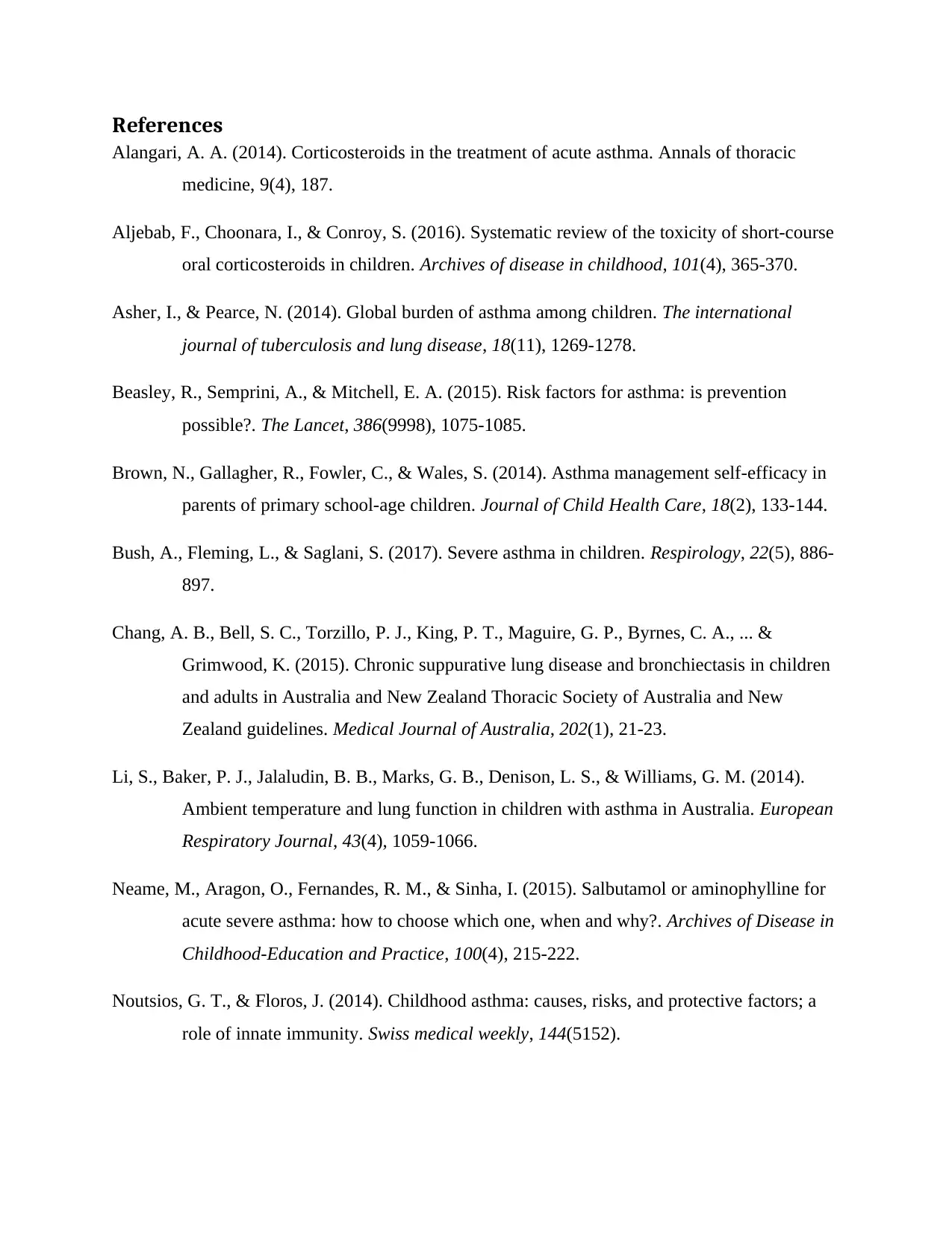
References
Alangari, A. A. (2014). Corticosteroids in the treatment of acute asthma. Annals of thoracic
medicine, 9(4), 187.
Aljebab, F., Choonara, I., & Conroy, S. (2016). Systematic review of the toxicity of short-course
oral corticosteroids in children. Archives of disease in childhood, 101(4), 365-370.
Asher, I., & Pearce, N. (2014). Global burden of asthma among children. The international
journal of tuberculosis and lung disease, 18(11), 1269-1278.
Beasley, R., Semprini, A., & Mitchell, E. A. (2015). Risk factors for asthma: is prevention
possible?. The Lancet, 386(9998), 1075-1085.
Brown, N., Gallagher, R., Fowler, C., & Wales, S. (2014). Asthma management self-efficacy in
parents of primary school-age children. Journal of Child Health Care, 18(2), 133-144.
Bush, A., Fleming, L., & Saglani, S. (2017). Severe asthma in children. Respirology, 22(5), 886-
897.
Chang, A. B., Bell, S. C., Torzillo, P. J., King, P. T., Maguire, G. P., Byrnes, C. A., ... &
Grimwood, K. (2015). Chronic suppurative lung disease and bronchiectasis in children
and adults in Australia and New Zealand Thoracic Society of Australia and New
Zealand guidelines. Medical Journal of Australia, 202(1), 21-23.
Li, S., Baker, P. J., Jalaludin, B. B., Marks, G. B., Denison, L. S., & Williams, G. M. (2014).
Ambient temperature and lung function in children with asthma in Australia. European
Respiratory Journal, 43(4), 1059-1066.
Neame, M., Aragon, O., Fernandes, R. M., & Sinha, I. (2015). Salbutamol or aminophylline for
acute severe asthma: how to choose which one, when and why?. Archives of Disease in
Childhood-Education and Practice, 100(4), 215-222.
Noutsios, G. T., & Floros, J. (2014). Childhood asthma: causes, risks, and protective factors; a
role of innate immunity. Swiss medical weekly, 144(5152).
Alangari, A. A. (2014). Corticosteroids in the treatment of acute asthma. Annals of thoracic
medicine, 9(4), 187.
Aljebab, F., Choonara, I., & Conroy, S. (2016). Systematic review of the toxicity of short-course
oral corticosteroids in children. Archives of disease in childhood, 101(4), 365-370.
Asher, I., & Pearce, N. (2014). Global burden of asthma among children. The international
journal of tuberculosis and lung disease, 18(11), 1269-1278.
Beasley, R., Semprini, A., & Mitchell, E. A. (2015). Risk factors for asthma: is prevention
possible?. The Lancet, 386(9998), 1075-1085.
Brown, N., Gallagher, R., Fowler, C., & Wales, S. (2014). Asthma management self-efficacy in
parents of primary school-age children. Journal of Child Health Care, 18(2), 133-144.
Bush, A., Fleming, L., & Saglani, S. (2017). Severe asthma in children. Respirology, 22(5), 886-
897.
Chang, A. B., Bell, S. C., Torzillo, P. J., King, P. T., Maguire, G. P., Byrnes, C. A., ... &
Grimwood, K. (2015). Chronic suppurative lung disease and bronchiectasis in children
and adults in Australia and New Zealand Thoracic Society of Australia and New
Zealand guidelines. Medical Journal of Australia, 202(1), 21-23.
Li, S., Baker, P. J., Jalaludin, B. B., Marks, G. B., Denison, L. S., & Williams, G. M. (2014).
Ambient temperature and lung function in children with asthma in Australia. European
Respiratory Journal, 43(4), 1059-1066.
Neame, M., Aragon, O., Fernandes, R. M., & Sinha, I. (2015). Salbutamol or aminophylline for
acute severe asthma: how to choose which one, when and why?. Archives of Disease in
Childhood-Education and Practice, 100(4), 215-222.
Noutsios, G. T., & Floros, J. (2014). Childhood asthma: causes, risks, and protective factors; a
role of innate immunity. Swiss medical weekly, 144(5152).
Paraphrase This Document
Need a fresh take? Get an instant paraphrase of this document with our AI Paraphraser
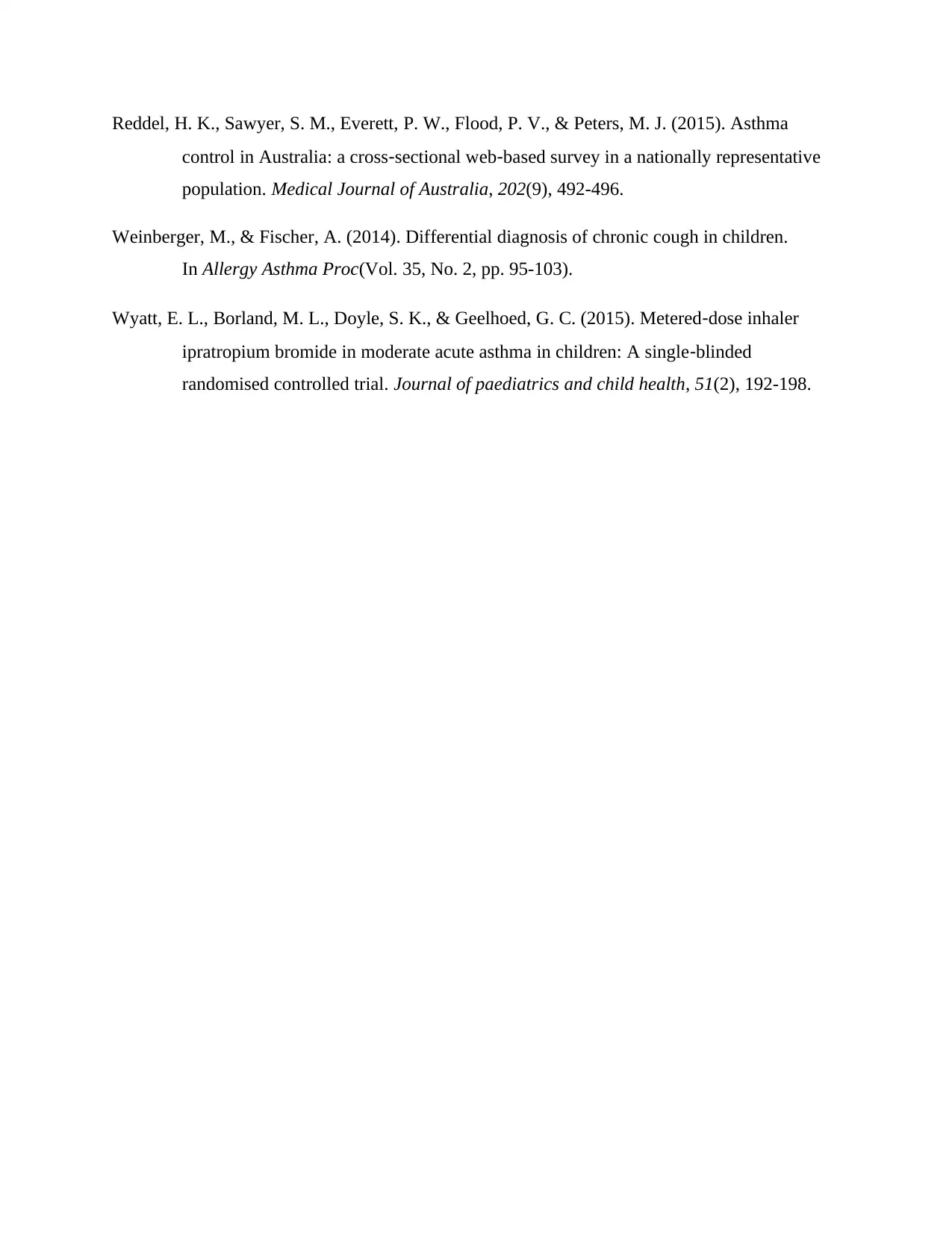
Reddel, H. K., Sawyer, S. M., Everett, P. W., Flood, P. V., & Peters, M. J. (2015). Asthma
control in Australia: a cross‐sectional web‐based survey in a nationally representative
population. Medical Journal of Australia, 202(9), 492-496.
Weinberger, M., & Fischer, A. (2014). Differential diagnosis of chronic cough in children.
In Allergy Asthma Proc(Vol. 35, No. 2, pp. 95-103).
Wyatt, E. L., Borland, M. L., Doyle, S. K., & Geelhoed, G. C. (2015). Metered‐dose inhaler
ipratropium bromide in moderate acute asthma in children: A single‐blinded
randomised controlled trial. Journal of paediatrics and child health, 51(2), 192-198.
control in Australia: a cross‐sectional web‐based survey in a nationally representative
population. Medical Journal of Australia, 202(9), 492-496.
Weinberger, M., & Fischer, A. (2014). Differential diagnosis of chronic cough in children.
In Allergy Asthma Proc(Vol. 35, No. 2, pp. 95-103).
Wyatt, E. L., Borland, M. L., Doyle, S. K., & Geelhoed, G. C. (2015). Metered‐dose inhaler
ipratropium bromide in moderate acute asthma in children: A single‐blinded
randomised controlled trial. Journal of paediatrics and child health, 51(2), 192-198.
1 out of 8